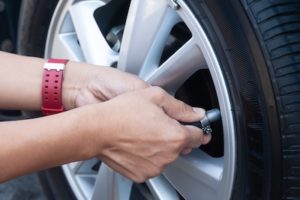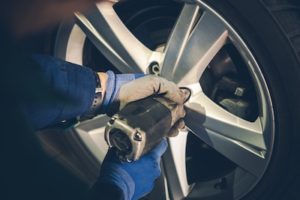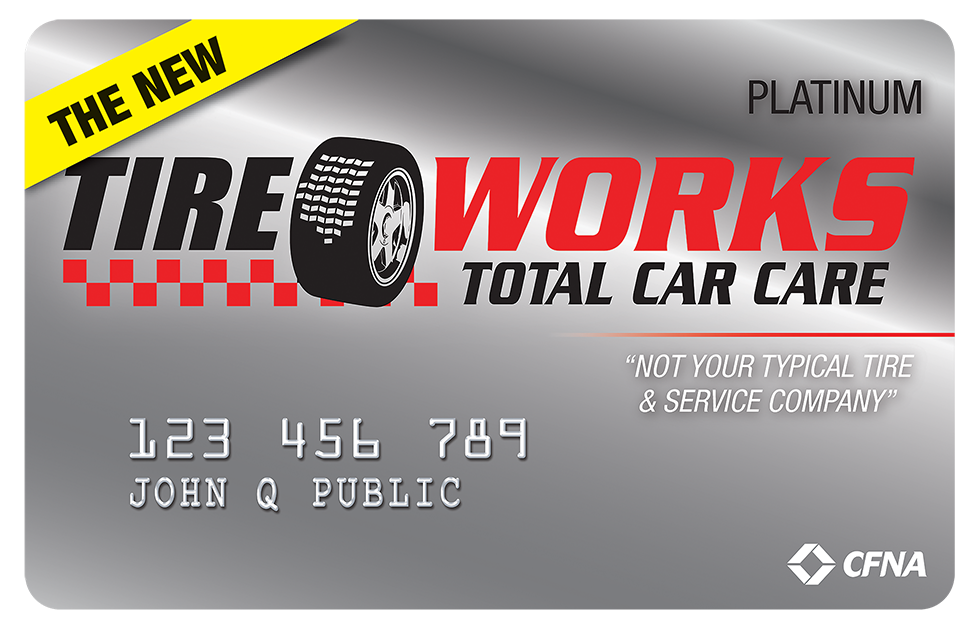Tire Maintenance Tips
Properly maintaining your tires can extend their life of and prevent tire blowouts. We have provided tire maintenance tips below to keep you safe on the road. Read our tips on tire pressure, alignments, tire rotation and tread.
How To Check Your Tire Pressure
Under-inflation can lead to tire failure. It results in unnecessary tire stress, irregular wear, loss of control and accidents. A tire can lose up to half of its air pressure and not appear to be flat.
It is important to have the proper air pressure in your tires, as underinflation can lead to tire failure. The "right amount" of air for your tires is specified by the vehicle manufacturer and is shown on the vehicle door edge, doorpost, glove box door or fuel door. It is also listed in the owner's manual. Follow the steps below when checking your tire pressure.
- When you check the air pressure, make
 sure the tires are cool — meaning they are not hot from driving even a mile. (NOTE: If you have to drive a distance to get air, check and record the tire pressure first and add the appropriate air pressure when you get to the pump. It is normal for tires to heat up and the air pressure inside to go up as you drive. Never "bleed" or reduce air pressure when tires are hot.)
sure the tires are cool — meaning they are not hot from driving even a mile. (NOTE: If you have to drive a distance to get air, check and record the tire pressure first and add the appropriate air pressure when you get to the pump. It is normal for tires to heat up and the air pressure inside to go up as you drive. Never "bleed" or reduce air pressure when tires are hot.) - Remove the cap from the valve on one tire.
- Firmly press a tire gauge onto the valve.
- Add air to achieve the recommended air pressure.
- If you overfill the tire, release air by pushing on the metal stem in the center of the valve with a fingernail or the tip of a pen. Then recheck the pressure with your tire gauge.
- Replace the valve cap.
- Repeat with each tire, including the spare. (NOTE: Some spare tires require higher inflation pressure.)
- Visually inspect the tires to make sure there are no nails or other objects embedded that could poke a hole in the tire and cause an air leak.
- Check the sidewalls to make sure there are no gouges, cuts, bulges or other irregularities. (NOTE: Air pressure in a tire goes up (in warm weather) or down (in cold weather) 1—2 pounds for every 10 degrees of temperature change.)
Tire Alignment Tips
A bad jolt from hitting a curb or pothole can throw your front end out of alignment and damage your tires. Misalignment of wheels in the front or rear can cause uneven and rapid treadwear and should be corrected by a tire dealer. Front-wheel-drive vehicles, and those with independent rear suspension, require alignment of all four wheels. Have your alignment checked periodically as specified by the vehicle owner's manual or whenever you have an indication of trouble such as “pulling” or vibration.
Also have your tire balance checked periodically. An unbalanced tire and wheel assembly may result in irregular wear.
Tire Rotation Tips
 You can slow down uneven tread wear by rotating your tires which simply means moving them around so that they "trade places" on your vehicle in a systematic way. Rotation is important because each tire on a car carries a different amount of weight, making them wear at different rates. By rotating them, you basically even out those differences. Your owner's manual will tell you how often to rotate your tires, but as a rule of thumb, it should be done every 6,000 to 8,000 miles. You might want to rotate them sooner if you see signs of uneven wear. Misalignment and other mechanical problems can also cause such wear, so check with your mechanic to determine the cause.
You can slow down uneven tread wear by rotating your tires which simply means moving them around so that they "trade places" on your vehicle in a systematic way. Rotation is important because each tire on a car carries a different amount of weight, making them wear at different rates. By rotating them, you basically even out those differences. Your owner's manual will tell you how often to rotate your tires, but as a rule of thumb, it should be done every 6,000 to 8,000 miles. You might want to rotate them sooner if you see signs of uneven wear. Misalignment and other mechanical problems can also cause such wear, so check with your mechanic to determine the cause.
There are various patterns for rotating tires. A common one for front-wheel drive vehicles involves moving the tires in a crisscross fashion, with the left front tire trading places with the right rear, and right front trading with the left rear. If you have a full-size spare, you can include it in your rotation pattern-but don't do so with a small "temporary use" spare, because those are meant only for low-speed, short-distance emergency use.
Check Your Tread
Another critical part of your tire is the tread, which gives you the traction to stop and hold the road on curves. Tire tread also funnels water out from under the tire, which helps to reduce "hydroplaning," where a car actually rides up on a layer of water and becomes dangerously difficult to steer or stop.
According to the NHTSA, about one out of every 10 cars on the road has at least one worn out or bald tire. There are several things you can do to stay out of that group, and help the tread last longer on your tires. For starters, make sure that your tire dealer balances your tires when installing them. Balancing involves placing small weights on the rim to counteract heavy spots, or slight variations in weight, in the wheel. If a tire is not balanced, it will shimmy as you drive, and your tread will wear down quickly. You must also make sure that your car's suspension is properly aligned.
If you have any questions about our tire maintenance tips, consult with one of our ASE-certified technicians. They will be happy to answer your questions.










